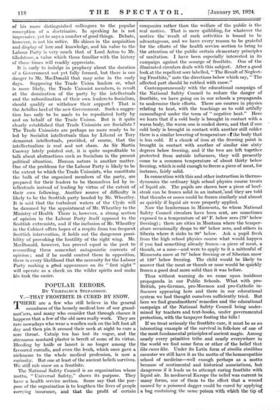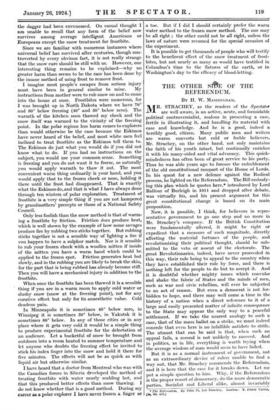POPULAR ERRORS.
BY VILIIJALMUR STEFANSSON.
V.-THAT FROSTBITE IS CURED BY SNOW.
/THERE are a few who still believe in the general soundness of the homely medical lore of our grand- moners, and many who consider that through chance it happens that a few of the old saws really work. They are rare nowadays who wear a woollen sock on the left foot all day and then pin it around their neck at night to cure a sore throat. Catnip tea has lost its vogue, and the Strenuous mustard plaster is bereft of some of its virtue. Bleeding by knife or lancet is no longer among the favoured curealls, and even the leech, which once gave a nickname to the whole medical profession, is now a curiosity. But one at least of the ancient beliefs survives. We still rub snow on a frostbite.
The National Safety Council is an organization whose motto, " Universal Safety," shows its purpose. They have a health service section. Some say that the pur- pose of the organization is to lengthen the lives of people carrying insurance, and that the profit of certain companies rather than the welfare of the public is the real motive. That is mere quibbling, for whatever the motive the 'result of such activities is bound to be advantageous, and we have every reason to be grateful for the efforts of the health service section to bring to the attention of the public certain elementary principles of sanitation. I have been especially interested in its campaign against the scourge of frostbite. One of the illustrated circulars deals with this subject. After a good look at the repellent sore labelled, " The Result of Neglect- ing Frostbite," note the directions below which say, " The affected part should be rubbed with snow."
Contemporaneously with the educational campaign of the National Safety Council to reduce the danger of frostbite, we have going on in our schools a propaganda to undermine their efforts. There are courses in physics relating to heat, with the teachings as to cold artfully camouflaged under the term of " negative heat." Here we learn that if a cold body is brought in contact with a warm body, the warm one is cooled down, and that if one cold body is brought in contact .with another still colder there is a similar lowering of temperature c f the body that is less cold. If a chunk of iron at the freezing point is . brought in contact with another of similar size sixty degrees below freezing, and if the two are left together protected from outside influences, they will presently come to a common temperature of about thirty below freezing, which is cold enoughto freeze a piece of meat, for instance, fairly solid.
In connextion with this and other instruction in thermo- dynamics the ordinary high school physics course treats of liquid air. The pupils are shown how a piece of beef- steak can be frozen solid in an instant; and they are told that thumbs or noses could be frozen similarly and almost as quickly if liquid air were properly applied.
Now the lumberman in Minnesota, to whom National. Safety Council circulars have been sent, are sometimes exposed to a temperature of 40° F. below zero (70° below freezing) ; there are cities in Montana where the temper- ature occasionally drops to 60° below zero, and others in Siberia where it sinks to 90° below. Ask a pupil fresh from the high school physics course what would happen if you had something already frozen—a piece of meat, a thumb, or a nose—and were to apply to it a mittenfill of Minnesota snow at 70° below freezing or of Siberian snow at 120° below freezing. The child would be likely to answer that the meat or thumb or nose would be quickly frozen a good deal more solid than it was before.
Thus without warning do we come upon insidious propaganda in our Public Schools. What with pro- British, pro-German, pro-Mormon and pro-Catholic in- fluences appearing here and there in our educational system we had thought ourselves sufficiently tried. But here we find grandmothers' remedies and the educational campaign of the National Safety Council being under- mined by teachers and text-books, under governmental protection, with the taxpayer footing the bills I If we treat seriously the frostbite cure, it must be as an interesting example of the survival in folk-lore of one of the most fundamental principles of ancient insgic. Among nearly every primitive tribe and nearly everywhere in the world we find some form or other of the belief that like cures like. Under its Latin form of similia similibus curantur we still have it as the motto of the homoeopathic school of medicine—well enough perhaps as a motto because of sentimental and historical associations, but dangerous if it leads us to attempt curing frostbite with liquid air. In mediaeval Europe the belief was current in many forms, one of them to the effect that a wound caused by a poisoned dagger could be cured by applying a bag containing the same-poison with which the tip of the dagger had been envenomed. On casual thought I am unable to recall that any form of the belief now survives among average intelligent Americans or Europeans except the snow treatment for frostbite.
Since we are familiar with numerous instances where universal belief has survived after centuries, though con- troverted by every obvious fact, it is not really strange that the snow cure should be still with us. However, one interesting thing remains to be explained—why no greater harm than seems to be the case has been done by the insane method of using frost to remove frost.
I imagine most people's escapes from serious injury must, have been in general similar to mine. My instructions from mother were to rub snow on and to come into the house at once. Frostbites were numerous, for I was brought up in North Dakota where we have 70° and 80° below freezing (40° and 50° below zero). The warmth of the kitchen soon thawed my cheek and the snow itself was warmed to the vicinity of the freezing point. In the polar regions less harm comes to explorers than would otherwise be the case because the Eskimos have never heard of the belief, and most white men feel inclined to treat frostbite as the Eskimos tell them to. The Eskimos do just what you would do if you did not know what to do. If you had no instructions on the subject, you would use your common sense. Something is freezing and you do not want it to freeze, so naturally you would apply warmth to thaw it out. The most convenient warm thing ordinarily is your hand, and you would apply that to the frozen cheek or nose, holding it there until the frost had disappeared. That is exactly what the Eskimos do, and that is what I have always done through ten winters of polar exploration. Treatment of frostbite is a very simple thing if you are not hampered by grandmothers' precepts or those of a National Safety Council.
Only less foolish than the snow method is that of warm- ing a frostbite by friction. Friction does produce heat, which is well shown by the example of how some savages produce fire by rubbing two sticks together. But rubbing sticks together is not a sensible way of lighting a fire if you happen to have a sulphur match. Nor is it sensible to rub your frozen cheek with a woollen mitten if inside of the mitten you have a warm hand which could be applied to the frozen spot. Friction generates heat but slowly, and in the rubbing you are likely to break the skin, for the part that is being rubbed has already become stiff. Then you will have a mechanical injury in addition to the frostbite.
When once the frostbite has been thawed it is a sensible thing if you are in a warm room to apply cold water or slushy snow -(snow at the freezing point), not for any curative effect but only for its anaesthetic value. Cold deadens pain.
In Minneapolis it is sometimes 40° below zero, in -Winnipeg it is sometimes 50° below, in Yakutsk it is sometimes 80° below. In any of those cities or in any place where it gets very cold it would be a simple thing -to produce experimental frostbite for the delectation of an audience. Let a bucketful of snow be brought from outdoors into a room heated to summer temperature and -let anyone who doubts the freezing effect be invited to -stick his index finger into the snow and hold it there for five minutes. The effects will not be as quick as with liquid air but otherwise similar.
I have heard that a doctor from Montreal who was with the Canadian forces in Siberia developed the method of treating frostbite with water nearly scalding hot, and that this produced better effects than snow thawing. I do not know whether that is a good method. During my _career as a polar explorer I have never frozen a finger or a toe. But if I did I should certainly prefer the warm water method to the frozen snow method. The one may be all right ; the other could not be all right, unless the laws of nature were reversed for the special occasion of the experiment.
It is possible to get thousands of people who will testify to the beneficent effect of the snow treatment of frost- bites, but not nearly as many as would have testified in Columbus's time to the flatness of the earth, or in Washington's day to the efficacy of blood-letting.



































 Previous page
Previous page